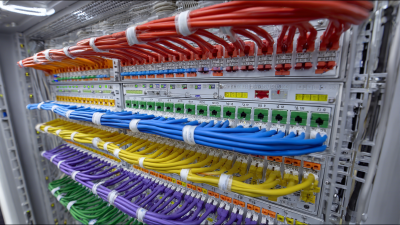7 Best Patch Cable Options for Seamless Connectivity Solutions in 2023
In the realm of modern connectivity, choosing the right patch cable is essential for ensuring seamless communication between devices in both professional and personal environments. With the ever-increasing demand for high-speed data transfer and reliable connections, understanding the various options available can make a significant difference in performance. This guide will explore the seven best patch cable options of 2023, providing insights into their features, benefits, and ideal applications. Whether you're setting up a home network, enhancing an office environment, or connecting audio/video equipment, selecting the appropriate patch cable can optimize your setup and facilitate uninterrupted connectivity. Join us as we delve into this essential aspect of networking and discover the top choices to elevate your connectivity solutions.

7 Key Factors to Consider When Choosing the Best Patch Cables in 2023
When choosing the best patch cables in 2023, several key factors should be considered to ensure seamless connectivity. First and foremost, the cable type plays a significant role in determining data transmission quality and speed. Options like Cat5e, Cat6, and fiber optic cables cater to different bandwidth needs, so understanding the specific requirements of your network is essential. Secondly, cable length can affect performance; longer cables may experience signal degradation, so selecting an appropriate length is crucial for optimal communication.
In light of increasing global concerns about the integrity of communication networks, it's also important to consider the resilience and protection of these patch cables. With events like the recent warnings from NATO highlighting the potential for sabotage of undersea cables, the focus on secure and durable cables is more critical than ever. Ensuring that your patch cables can withstand environmental factors and stress is vital in maintaining reliable connectivity in today's data-driven world. Therefore, investing in high-quality cables that offer enhanced durability and performance is a smart strategy for any modern network setup.
7 Best Patch Cable Options for Seamless Connectivity Solutions in 2023
Understanding the Variations: Cat5e vs. Cat6 vs. Cat6a Patch Cables
When it comes to networking, choosing the right patch cable is crucial for ensuring optimal performance. Cat5e, Cat6, and Cat6a cables are prevalent choices, each offering unique benefits tailored to specific networking needs. According to a report from the Telecommunications Industry Association (TIA), Cat5e cables support speeds of up to 1 Gbps with a bandwidth of 100 MHz, making them suitable for most home and small business applications. However, for environments requiring higher performance, such as data centers, Cat6 cables stand out with their capability of handling up to 10 Gbps over short distances, while accommodating a broader bandwidth of 250 MHz.
Moving further up the spectrum, Cat6a cables take the lead, designed to deliver enhanced performance in gigabit networking environments. With the potential to maintain speeds of 10 Gbps across distances up to 100 meters, Cat6a is also equipped to handle bandwidths of 500 MHz, as per the latest industry standards. This makes them ideal for high-density applications and future-proofing against the increasing demands of data traffic. Thus, selecting the right cable not only influences immediate connectivity solutions but also prepares your network for future advancements in technology.
The Impact of Cable Length on Signal Quality and Network Efficiency
In modern networking, the impact of cable length on signal quality and network efficiency cannot be overstated. As reported by the TIA (Telecommunications Industry Association), signal degradation starts to occur as cable lengths exceed critical thresholds. For instance, Ethernet cables, such as the common Cat6, can maintain optimal performance up to 55 meters for 10 Gigabit Ethernet applications. Beyond this length, attenuation increases, which can significantly compromise data speeds and connectivity reliability.
Moreover, the environment in which the cables operate plays a pivotal role. A study by the IEEE (Institute of Electrical and Electronics Engineers) indicates that external factors like electromagnetic interference (EMI) can adversely affect longer cables. In professional settings, it is recommended to keep cables as short as feasible to minimize latency and maximize throughput. This is particularly relevant in high-density networking environments where every millisecond of latency counts, and high-efficiency performance is paramount for applications like video streaming and online gaming. By carefully considering cable length, businesses can enhance network efficiency and ensure seamless connectivity in their operations.
Assessing Shielding Techniques: Unshielded vs. Shielded Patch Cables
When it comes to choosing the right patch cable for your networking needs, understanding the differences between unshielded and shielded options is crucial. Unshielded Twisted Pair (UTP) cables are designed to reduce crosstalk and electromagnetic interference but are less effective in high-noise environments. According to a report by the Telecommunications Industry Association (TIA), UTP cables account for approximately 80% of the structured cabling installations in commercial buildings due to their cost-effectiveness and flexibility for short-range data transmission.
On the other hand, Shielded Twisted Pair (STP) cables offer additional protection through a layer of shielding that minimizes interference, making them ideal for installations in areas with heavy machinery or radio frequency interference. The International Electrotechnical Commission (IEC) indicates that using shielded cables can yield a 20-30% improvement in data integrity in such environments. As businesses continue to rely on fast and reliable connectivity, the choice between unshielded and shielded patch cables will play a pivotal role in their ability to maintain high performance and efficiency in networking solutions.

Emerging Technologies in Patch Cables: Future-Proofing Your Connectivity Solutions
As connectivity solutions continue to evolve, the role of patch cables becomes increasingly pivotal in ensuring seamless performance across various industries. Emerging technologies in the realm of patch cables, such as enhanced diagnostics and increased bandwidth capabilities, are essential for businesses aiming to future-proof their networking infrastructure. Recent advancements in broadband technology are showcasing a shift towards ultra-fast connections, with some markets reporting upgrades to 10 Gbps, dramatically outperforming previous standards and enabling unprecedented data transfer speeds essential for modern applications.
In this dynamic landscape, companies are recognizing the importance of adaptable and reliable connectivity solutions. Research indicates that Ethernet cables remain the fastest and most dependable choice for computer networking, supporting both current and future technological demands. Additionally, partnerships aimed at increasing network automation and diagnostics are transforming deployment strategies, providing businesses with the tools necessary to navigate complex network environments effectively. As the demand for high-speed internet continues to rise, the careful selection of patch cables will play a crucial role in enabling organizations to maintain a competitive edge in their respective markets.

Related Posts
-

Innovative Solutions for Enhancing Network Performance with Quality Patch Cables
-

What is the Importance of Network Fiber Optic Cable in Modern Communication
-

How to Choose the Right UTP Cat 6 Cables for Your Network Needs
-

What is a Fiber Optic Patch Cord and How Does It Improve Connectivity
-

7 Best Practices for Selecting the Right Patch Panel for Your Network
-

Common Issues Faced When Sourcing Bulk Cat 6 Cable for Global Supply Chains
